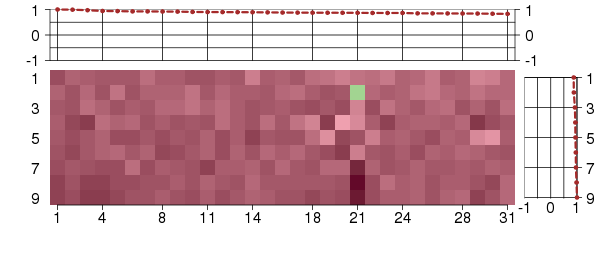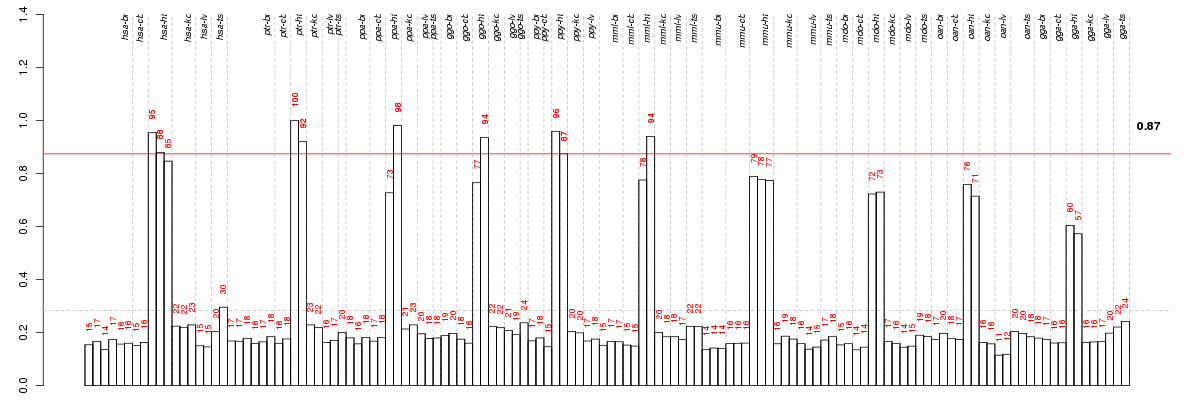



Under-expression is coded with green,
over-expression with red color.

system process
A multicellular organismal process carried out by any of the organs or tissues in an organ system. An organ system is a regularly interacting or interdependent group of organs or tissues that work together to carry out a biological objective.
muscle system process
A organ system process carried out at the level of a muscle. Muscle tissue is composed of contractile cells or fibers.
muscle contraction
A process whereby force is generated within muscle tissue, resulting in a change in muscle geometry. Force generation involves a chemo-mechanical energy conversion step that is carried out by the actin/myosin complex activity, which generates force through ATP hydrolysis.
striated muscle contraction
A process whereby force is generated within striated muscle tissue, resulting in the shortening of the muscle. Force generation involves a chemo-mechanical energy conversion step that is carried out by the actin/myosin complex activity, which generates force through ATP hydrolysis. Striated muscle is a type of muscle in which the repeating units (sarcomeres) of the contractile myofibrils are arranged in registry throughout the cell, resulting in transverse or oblique striations observable at the level of the light microscope.
biological_process
Any process specifically pertinent to the functioning of integrated living units: cells, tissues, organs, and organisms. A process is a collection of molecular events with a defined beginning and end.
multicellular organismal process
Any biological process, occurring at the level of a multicellular organism, pertinent to its function.
all
NA

intracellular
The living contents of a cell; the matter contained within (but not including) the plasma membrane, usually taken to exclude large vacuoles and masses of secretory or ingested material. In eukaryotes it includes the nucleus and cytoplasm.
contractile fiber
Fibers, composed of actin, myosin, and associated proteins, found in cells of smooth or striated muscle.
cellular_component
The part of a cell or its extracellular environment in which a gene product is located. A gene product may be located in one or more parts of a cell and its location may be as specific as a particular macromolecular complex, that is, a stable, persistent association of macromolecules that function together.
cell
The basic structural and functional unit of all organisms. Includes the plasma membrane and any external encapsulating structures such as the cell wall and cell envelope.
cytoplasm
All of the contents of a cell excluding the plasma membrane and nucleus, but including other subcellular structures.
myofibril
The contractile element of skeletal and cardiac muscle; a long, highly organized bundle of actin, myosin, and other proteins that contracts by a sliding filament mechanism.
sarcomere
The repeating unit of a myofibril in a muscle cell, composed of an array of overlapping thick and thin filaments between two adjacent Z discs.
I band
A region of a sarcomere that appears as a light band on each side of the Z disc, comprising a region of the sarcomere where thin (actin) filaments are not overlapped by thick (myosin) filaments; contains actin, troponin, and tropomyosin; each sarcomere includes half of an I band at each end.
organelle
Organized structure of distinctive morphology and function. Includes the nucleus, mitochondria, plastids, vacuoles, vesicles, ribosomes and the cytoskeleton, and prokaryotic structures such as anammoxosomes and pirellulosomes. Excludes the plasma membrane.
non-membrane-bounded organelle
Organized structure of distinctive morphology and function, not bounded by a lipid bilayer membrane. Includes ribosomes, the cytoskeleton and chromosomes.
intracellular organelle
Organized structure of distinctive morphology and function, occurring within the cell. Includes the nucleus, mitochondria, plastids, vacuoles, vesicles, ribosomes and the cytoskeleton. Excludes the plasma membrane.
intracellular non-membrane-bounded organelle
Organized structure of distinctive morphology and function, not bounded by a lipid bilayer membrane and occurring within the cell. Includes ribosomes, the cytoskeleton and chromosomes.
organelle part
Any constituent part of an organelle, an organized structure of distinctive morphology and function. Includes constituent parts of the nucleus, mitochondria, plastids, vacuoles, vesicles, ribosomes and the cytoskeleton, but excludes the plasma membrane.
intracellular part
Any constituent part of the living contents of a cell; the matter contained within (but not including) the plasma membrane, usually taken to exclude large vacuoles and masses of secretory or ingested material. In eukaryotes it includes the nucleus and cytoplasm.
cytoplasmic part
Any constituent part of the cytoplasm, all of the contents of a cell excluding the plasma membrane and nucleus, but including other subcellular structures.
contractile fiber part
Any constituent part of a contractile fiber, a fiber composed of actin, myosin, and associated proteins, found in cells of smooth or striated muscle.
cell part
Any constituent part of a cell, the basic structural and functional unit of all organisms.
all
NA
cell part
Any constituent part of a cell, the basic structural and functional unit of all organisms.
organelle part
Any constituent part of an organelle, an organized structure of distinctive morphology and function. Includes constituent parts of the nucleus, mitochondria, plastids, vacuoles, vesicles, ribosomes and the cytoskeleton, but excludes the plasma membrane.
intracellular non-membrane-bounded organelle
Organized structure of distinctive morphology and function, not bounded by a lipid bilayer membrane and occurring within the cell. Includes ribosomes, the cytoskeleton and chromosomes.
intracellular part
Any constituent part of the living contents of a cell; the matter contained within (but not including) the plasma membrane, usually taken to exclude large vacuoles and masses of secretory or ingested material. In eukaryotes it includes the nucleus and cytoplasm.
intracellular organelle
Organized structure of distinctive morphology and function, occurring within the cell. Includes the nucleus, mitochondria, plastids, vacuoles, vesicles, ribosomes and the cytoskeleton. Excludes the plasma membrane.
I band
A region of a sarcomere that appears as a light band on each side of the Z disc, comprising a region of the sarcomere where thin (actin) filaments are not overlapped by thick (myosin) filaments; contains actin, troponin, and tropomyosin; each sarcomere includes half of an I band at each end.
cytoplasmic part
Any constituent part of the cytoplasm, all of the contents of a cell excluding the plasma membrane and nucleus, but including other subcellular structures.
contractile fiber
Fibers, composed of actin, myosin, and associated proteins, found in cells of smooth or striated muscle.
contractile fiber part
Any constituent part of a contractile fiber, a fiber composed of actin, myosin, and associated proteins, found in cells of smooth or striated muscle.
contractile fiber part
Any constituent part of a contractile fiber, a fiber composed of actin, myosin, and associated proteins, found in cells of smooth or striated muscle.
sarcomere
The repeating unit of a myofibril in a muscle cell, composed of an array of overlapping thick and thin filaments between two adjacent Z discs.

| Id | Pvalue | ExpCount | Count | Size | Term |
|---|---|---|---|---|---|
| 05410 | 1.996e-02 | 0.1641 | 3 | 34 | Hypertrophic cardiomyopathy (HCM) |
| 05414 | 1.996e-02 | 0.1641 | 3 | 34 | Dilated cardiomyopathy |
ANKRD1ankyrin repeat domain 1 (cardiac muscle) (ENSG00000148677), score: 0.92 ASB11ankyrin repeat and SOCS box-containing 11 (ENSG00000165192), score: 0.92 CMYA5cardiomyopathy associated 5 (ENSG00000164309), score: 0.84 CSRP3cysteine and glycine-rich protein 3 (cardiac LIM protein) (ENSG00000129170), score: 0.86 DUSP27dual specificity phosphatase 27 (putative) (ENSG00000198842), score: 0.89 FAM129Afamily with sequence similarity 129, member A (ENSG00000135842), score: 0.87 FBXO40F-box protein 40 (ENSG00000163833), score: 0.85 FGF18fibroblast growth factor 18 (ENSG00000156427), score: 0.83 GCOM1GRINL1A complex locus (ENSG00000137878), score: 0.86 KBTBD10kelch repeat and BTB (POZ) domain containing 10 (ENSG00000239474), score: 0.89 KLHL31kelch-like 31 (Drosophila) (ENSG00000124743), score: 0.9 KLHL38kelch-like 38 (Drosophila) (ENSG00000175946), score: 0.97 LMOD2leiomodin 2 (cardiac) (ENSG00000170807), score: 0.88 LRRC39leucine rich repeat containing 39 (ENSG00000122477), score: 0.91 MAPKAPK3mitogen-activated protein kinase-activated protein kinase 3 (ENSG00000114738), score: 0.87 METTL11Bmethyltransferase like 11B (ENSG00000203740), score: 0.87 MYBPC3myosin binding protein C, cardiac (ENSG00000134571), score: 0.83 MYOM3myomesin family, member 3 (ENSG00000142661), score: 0.99 MYOZ2myozenin 2 (ENSG00000172399), score: 0.9 MYPNmyopalladin (ENSG00000138347), score: 0.92 PPP1R3Aprotein phosphatase 1, regulatory (inhibitor) subunit 3A (ENSG00000154415), score: 1 PTDSS1phosphatidylserine synthase 1 (ENSG00000156471), score: 0.87 SGCGsarcoglycan, gamma (35kDa dystrophin-associated glycoprotein) (ENSG00000102683), score: 0.85 SLC26A9solute carrier family 26, member 9 (ENSG00000174502), score: 0.84 SLC41A1solute carrier family 41, member 1 (ENSG00000133065), score: 0.86 TBX20T-box 20 (ENSG00000164532), score: 0.85 TECRLtrans-2,3-enoyl-CoA reductase-like (ENSG00000205678), score: 0.93 TMEM182transmembrane protein 182 (ENSG00000170417), score: 0.94 TPM1tropomyosin 1 (alpha) (ENSG00000140416), score: 0.9 ZAKsterile alpha motif and leucine zipper containing kinase AZK (ENSG00000091436), score: 0.88 ZNF330zinc finger protein 330 (ENSG00000109445), score: 0.94
| Id | species | tissue | sex | individual |
|---|---|---|---|---|
| ppy_ht_f_ca1 | ppy | ht | f | _ |
| hsa_ht_m2_ca1 | hsa | ht | m | 2 |
| ptr_ht_f_ca1 | ptr | ht | f | _ |
| ggo_ht_f_ca1 | ggo | ht | f | _ |
| mml_ht_f_ca1 | mml | ht | f | _ |
| hsa_ht_m1_ca1 | hsa | ht | m | 1 |
| ppy_ht_m_ca1 | ppy | ht | m | _ |
| ppa_ht_f_ca1 | ppa | ht | f | _ |
| ptr_ht_m_ca1 | ptr | ht | m | _ |
